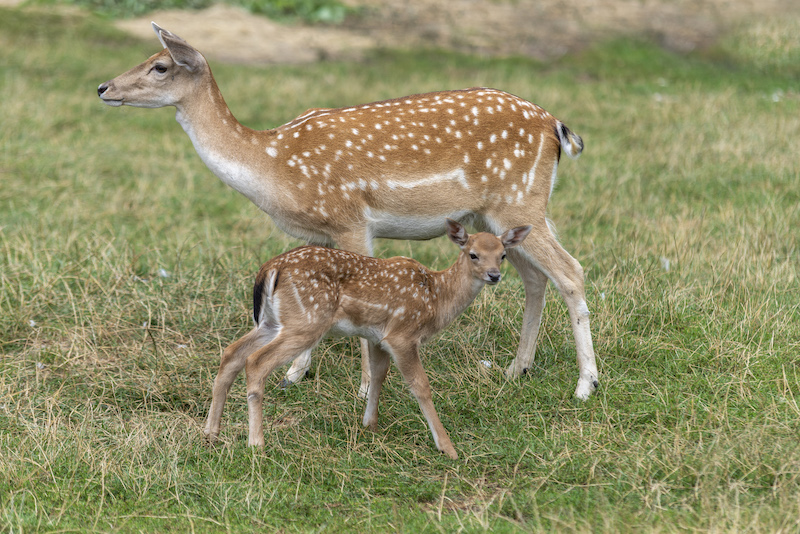Originally from North America, the whitetail deer is an iconic and fascinating creature. The whitetail deer, renowned for its elegant demeanor and splendid antlers, goes through a fantastic life cycle that sees it develop from a helpless youngster into a stately buck. An in-depth examination of the growth, habits, and adaptations of these amazing animals will be provided in this article as it delves into the numerous phases of the life cycle of the whitetail deer.
- Birth and Infancy
Normal birthing behavior for female deer occurs away from the herd. So that the fawn is protected from predators, they pick a region with lots of vegetation. Another defense mechanism is the mother’s tendency to lick the fawn clean of the birth fluid that masks its odor. Upon birth, a baby may stand within 20 minutes. Thus, the mother will encourage the fawn to stand.
While being fed by its mother, the fawn will spend the first week of its life hiding in vegetation; the female will return frequently to nurse the fawn. They are shielded from predators during this time of isolation, which also helps their muscles and coordination grow. Once strong enough, the fawn joins the herd after about a week. A single fawn is more likely, while female deer can occasionally give birth to twins, and triplets have also been known to happen.
- Juvenile Deer
Upon birth, the fawn has white spots all over its fur, which acts as a camouflage with the surroundings. Except for fallow deer, who maintain their spots throughout their lives, they will hold onto them for around a year.
Fawns reach their adolescent stage around the age of six months. The bachelor groups that young deer form are made up of bucks around the same age. These groups give them opportunities for safety and socializing, allowing them to perfect their habits and create hierarchical systems.
The fawn will nurse from its mother for three to four months while remaining with her for almost a year. Before giving birth to the coming year fawn, the female will drive the juvenile away to break the mother’s bound.
- Young Adult Deer
Typically, females stay with the same herd and mate annually with the dominant male. In contrast, the herd may occasionally be split apart during fights between male rivals.
Often, young males will stick with the herd and compete with the dominant male for the privilege to reproduce. Whereas sometimes, the young males while break away from the herd in search of a male rival.
Development of Antlers
Whitetail deer males start to acquire antlers by the time they are two years old. The antlers begin as little, two-pointed structures that are simple and compact. The antlers increase in size, complexity, and number of points as the buck ages each year. Antlers are mainly used for territorial displays and dominance struggles during the rut or mating season. Hormones are responsible for hormone-driven antler growth, illustrating the animal kingdom’s fast tissue expansion.
Mating Season and Reproduction
The mating season starts in the fall, and bucks become more competitive and aggressive. To draw females, they vocalize, mark their territory with their antlers, and rub their antlers against trees. Rival bucks engage in fierce competition during this time to establish supremacy and gain access to females for mating. The continuity of a buck’s genetic line is ensured by its successful mating with numerous does. The lifecycle is completed when the does birth to the next generation of fawns after a gestation period of roughly six to seven months.
Life Expectancy for Deer
Deer have a 20-year lifespan in the wild. Few animals will live to that age because older animals frequently become prey for predators and pass away from disease.
Also, predators and some hunters will kill numerous fawns, which is why in Texas, there are rules and regulations to follow during deer hunting. Deer can live up to 30 years in captivity.
Conclusion
A whitetail deer goes through several stages in its life cycle, from the defenseless fawn stage to the beautiful buck with impressive antlers. These amazing creatures enrich their thriving ecosystems by adapting, socializing, and having a strong desire to procreate. They also capture the interest of nature lovers all over the world.
Today is the Day to go on a Whitetail Deer Hunt in Texas.
At Squaw Mountain Ranch, one of our favorite activities is whitetail deer hunting. Compared to other ranches, we offer exceptional whitetail deer trophy hunts at a reasonable price and provide the hunter with unmatched five-star treatment and service. We have the most land and the best whitetail deer hunting in Texas.

